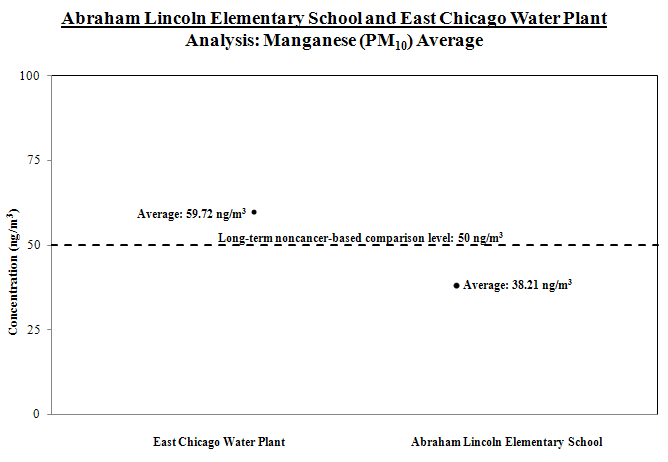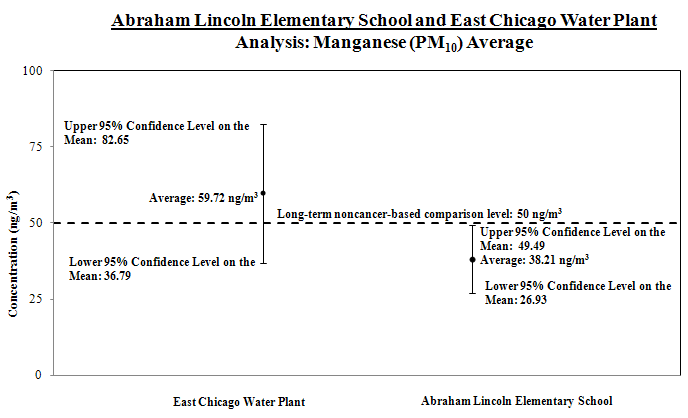Assessing Outdoor Air Near Schools
Abraham Lincoln Elementary School - East Chicago, IN
- Understanding the Monitoring Data
- Initial Sample Results
- Initial Analysis
- Additional Sample Results
- Final Analysis
Results and Analysis of EPA’s monitoring
EPA selected this school for monitoring because it was located near a coke oven and steel mill which are sources of air toxics emissions. Air monitoring was initially conducted at Abraham Lincoln Elementary School from August 23, 2009 through December 9, 2009 to assess concentrations of manganese and lead, as well as chemicals associated with coke oven emissions, such as benzene, arsenic, and benzo(a)pyrene in the air. EPA extended air toxics monitoring at the school and the East Chicago Water Plant which is closer to the source, because measurements of manganese were elevated and indicated a potential concern for long-term, continuous exposure. Additional monitoring for manganese was conducted from September 5, 2010 through April 3, 2011.
| Primary Findings | The second round of monitoring indicates that the longer-term concentration estimate for manganese (PM10) are near levels of potential concern for long-term continuous exposure at the East Chicago Water Plant monitoring location, a site closer to the source than the Abraham Lincoln Elementary School. The second round of monitoring indicates that the longer-term concentration estimate for manganese (PM10) at Abraham Lincoln Elementary School monitoring location are below levels of concern. |
| Key Pollutants Monitored | Manganese. Inhalation may affect the nervous system if people are exposed to high levels. |
| Next Steps | The Indiana Department of Environmental Management (IDEM) will continue to oversee industrial facilities in the area through air permits and other programs. EPA Region 5 currently has an ongoing enforcement case with the source. |
Summary of Study Approach and Findings
Approach:
- A monitor collected air samples from September 5, 2010 through April 3, 2011 Abraham Lincoln Elementary School and the East Chicago Water Plant in East Chicago, Indiana.
- Individual air sample results are posted on this website.
- When the monitoring was complete, we analyzed the results to see if there was a concern from long-term concentrations (over a lifetime).
- Also, when the monitoring was complete, we evaluated all the air samples from the on-site monitor. We also evaluated information on wind speed and wind direction from a weather monitor, along with historical weather information and information about nearby sources of manganese emissions.
Findings:
- Measured values of manganese indicate an influence of the source at the school and the East Chicago Water Plant.
- Levels of manganese are below levels of concern for short-term and long-term exposure at the school. However, levels of manganese are below levels of concern for short-term, but remain a concern for long term at the East Chicago Water Plant.
- Information about the nearby source indicates that the facility had no significant change in production during the monitoring period
- Click here for additional information
The analysis considered whether the information collected at the school might raise concerns for the health of children or adults at the school. We looked at the following types of information:
- Measured concentrations and information on manganese
- Measured wind direction and wind speed
- Information about nearby sources of manganese
Analysis of Measured Manganese Concentrations:
1. Calculate the average: We calculated the average of the manganese measurements (shown by the black diamond in the graph below). We compared this average to the long-term comparison level (thick line on the graph below).
Result: The average manganese level for the samples collected was below the long-term comparison level at Abraham Lincoln Elementary School but above at the East Chicago Water Plant.

2. Calculate a range: To account for varying air concentrations of manganese, we calculated a range around the average. We did this by estimating high and low values that the longer-term concentrations might reach using common statistical tools. We compared the highest point in the range (called the “upper bound”) to the long-term comparison level.
Result: The high end of the range is lower than the comparison level at Abraham Lincoln Elementary School but above the comparison level at East Chicago Water Plant.

Analysis of Measured Wind Direction and Wind Speed at a meteorological station operated by IDEM (located 2.5 miles WSW of the school and 3 miles WSW from the water plant)
We took measurements of wind direction and speed every day during the sample period. We took special note of the wind speed and direction on the days we took measurements.
| What we looked at | What we found |
We looked at whether the wind data taken on the days we took measurements of are similar or different from the wind patterns during the entire sampling period. |
The wind patterns across sampling dates are similar to those observed across the full record of on-site meteorological data, with respect to the expected zone of source influence. |
We looked at whether the wind pattern during the sampling period is reflective of regional wind pattern over the long term. |
The wind pattern at the National Weather Station (NWS) station during the sampling period is similar to the historical long-term wind flow pattern at that same NWS station. Therefore, the 7-month sampling period may be representative of year-round wind patterns. |
Analysis of Information on Nearby Source of Manganese Emissions
| What we looked at | What we found |
Whether we could determine if the source was operating as usual during the sampling period |
Information about the nearby source indicates that the facility had no significant change in production during the monitoring period. |
The nearby source of the key pollutant has an operating permit issued by IDEM that includes operating requirements. |
Additional Information
Technical Report for School: Assessing Outdoor Air Near Schools: Additional Monitoring at Abraham Lincoln Elementary School (East Chicago, Indiana) (PDF) (30pp,585k). The technical report is a follow-up to the original monitoring. The report is geared toward risk assessors, risk managers, and other regulatory agencies.
Background on School Monitoring Effort
General Questions and Answers for School Monitoring Effort
